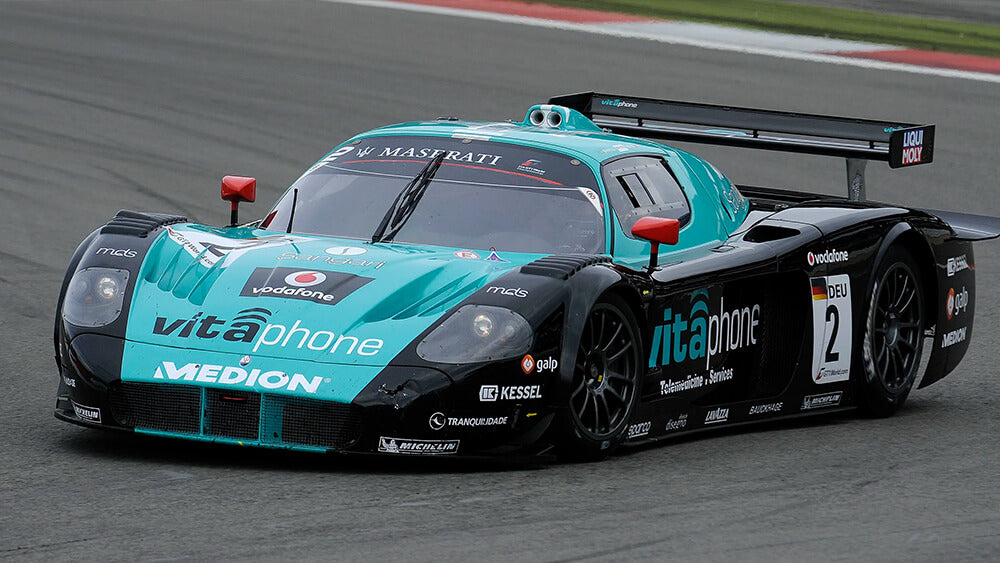In 2004, Maserati decided it was time to go racing again after a short break of just 37 years. In order to compete in the Fia GT Championship, rules required that a manufacturer build 25 examples of the car and so the MC12 was born, a true supercar of its time, built on the chassis of an existing iconic machine, the Ferrari Enzo.
The Modena marque started racing towards the end of that year, winning at the Zhuhai circuit in China. The car’s development was directed by Giorgio Ascanelli, the highly regarded Formula 1 engineer. While accomplished sports car racer Andrea Bertolini did most of the testing, a certain Michael Schumacher also spent plenty of time thrashing the car round Ferrari’s Fiorano circuit, as the Prancing Horse and Maserati are all part of the same family.
Various designs were initially tried out in the Maserati wind tunnel, to deliver the right sort of aerodynamics required for racing, while legendary Italian sports car designer Giorgetto Giugiaro was brought in to add some aesthetics. However, most of the bodywork styling was down to Maserati’s own head of design, Frank Stephenson, who incorporated the trademark Maserati grille featuring the Trident emblem. The original plan was to build two models: one for racing, the MCC or Maserati Corse Competizione and another for the road, the MCS or Maserati Corse Stradale, although eventually both were renamed as Maserati MC12.
 The speedy Maserati MC12 making its mark at the FIA GT in Navarra, Spain in 2010. Image courtesy Maserati
The speedy Maserati MC12 making its mark at the FIA GT in Navarra, Spain in 2010. Image courtesy Maserati
A supercar demanded supercar pricing and the “base” model came in at 800,000 US dollars, while the 12 “Versione Corse” were yours for an eye-watering 1.47 million dollars! In total, just 62 MCs were ever built. The Versione Corse was built in 2006 for customers who were demanding a more extreme version of the MC12 GT1, which had won the 2005 FIA World Endurance Championship. It was not road legal and was a pure track day car, with its naturally aspirated V12 engine putting out 755 horsepower. Stripped down to 1,150 kilos it can go from 0 to 200 km/h in just 6.4 seconds with a top speed of over 330 km/h. In short, its performance was amazing and exhilarating.
 The MC12 Versione Corse was developed starting from the MC12 GT1 type and introduced in 2006. Image courtesy Maserati
The MC12 Versione Corse was developed starting from the MC12 GT1 type and introduced in 2006. Image courtesy Maserati
On the race track, the MC12 proved to be truly dominant in its day. As is often the case with sports car racing, if one car seems to have a big advantage over the rest of the field, the rule makers try and hobble it in some way. But despite several attempts to slow it down, it just kept on winning. The MC12 was simply a cut above cars like the Aston Martin DBR9 and the Ferrari 550. However, the one race missing from the car’s “palmares” is the Le Mans 24 Hours as it was simply not allowed to race there. When it first took to the track at Imola in 2004, there was some controversy over its homologation, but from 2005 until 2010, It won the FIA GT and GT1 championships every year, getting the better of a host of top class teams and world class drivers. This was despite being heavily restricted by what would come to be known as the “Balance of Performance” factor, when cars had to carry additional weight based on past success. Some of the MC12’s inherent technical advantage came from its links with Ferrari and under the bodywork, it boasted all sorts of Formula 1 tech. The original development actually used a Ferrari Enzo as the mule car and Maserati assembled a team of around a hundred engineers and technicians to work on the project.
 The Maserati MC12 GT1 leading at the 2005 GT Championship in Monza, Italy. Image courtesy Hoch Zwei
The Maserati MC12 GT1 leading at the 2005 GT Championship in Monza, Italy. Image courtesy Hoch Zwei
The car was born in an era where on-track testing was still the main way forward when it came to fine-tuning and developing race machinery. This was the era when F1 teams would spend almost every day between the grands prix pounding round a race track. Ferrari certainly made the most of having its own race track at Fiorano and this was where the MC12 had its first shakedown in the hands of Bertolini. For its first run, all the big guns from Ferrari and Maserati were present, including president Luca di Montezemolo and Ferrari F1 boss Jean Todt. Actually, it was an inauspicious start, as a driveshaft failed on the very first lap and the car then spent three hours in the garage before bursting back into life and reeling off almost 500 kilometres. Testing would take place for four or five days every fortnight, much of it at the Paul Ricard track in France, but also at Monza and Vallelunga. When the testing was done and it was time to go racing, Bertolini told his team, “guys, we are now four or five years in front of everyone in terms of the car.” It definitely was, which caused some headaches as the FIA soon asked for modifications to slow its performance, including making the nose shorter, adopting a smaller rear wing and different diffuser, drastically reducing its downforce. And the changes didn’t stop there, but the car still kept on winning. The MC12 hammered the opposition.














































